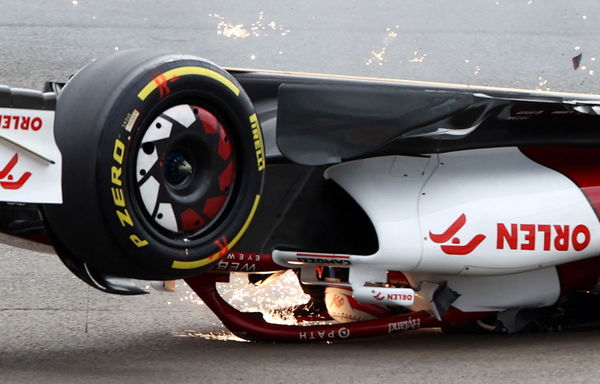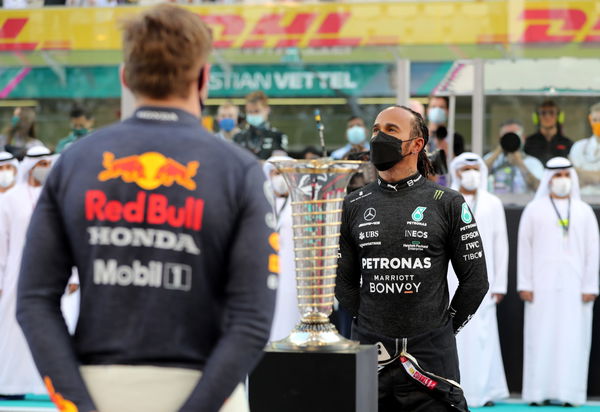
Getty
MONZA, ITALY – SEPTEMBER 12: Max Verstappen of the Netherlands driving the (33) Red Bull Racing RB16B Honda and Lewis Hamilton of Great Britain driving the (44) Mercedes AMG Petronas F1 Team Mercedes W12 crash during the F1 Grand Prix of Italy at Autodromo di Monza on September 12, 2021 in Monza, Italy. (Photo by Peter Van Egmond/Getty Images)

Getty
MONZA, ITALY – SEPTEMBER 12: Max Verstappen of the Netherlands driving the (33) Red Bull Racing RB16B Honda and Lewis Hamilton of Great Britain driving the (44) Mercedes AMG Petronas F1 Team Mercedes W12 crash during the F1 Grand Prix of Italy at Autodromo di Monza on September 12, 2021 in Monza, Italy. (Photo by Peter Van Egmond/Getty Images)
When cars are flying at 200+ miles/hour, there are a lot of risks involved and things can go awry at any moment. This is exactly why safety has become a priority in F1. The sport takes countless measures for the safety of the drivers and their well-being, especially since the last fatality in the sport. However, sometimes to ensure their well-being the drivers are treated with some tough love.
Watch What’s Trending Now!
ADVERTISEMENT
The sport takes no prisoners when it comes to dangerous and unfair driving. This is exactly why discipline is enforced in the form of penalties. The drivers are penalized for any and every infringement of rules during or before the race. The penalties are levied by race stewards with their word as bond.
With the race stewards holding all the power over the drivers during a race in terms of penalties, let’s look at penalties for causing an accident in F1.
ADVERTISEMENT
Different types of F1 penalties and how they are applied
The penalization system is put in place to encourage drivers to stick to regulations and stay away from misdemeanors. The misdemeanors include blocking, pushing track limits, ignoring flags, speeding in the pits, or driving dangerously. All these are punishable offenses by the stewards because any such incident can result in horrifying and life-threatening injuries for the drivers. Even though some legends of the sport have opposed the excessive safety measures, modern-day F1 is heavily focused on safety.
ADVERTISEMENT

Reuters
Formula One F1 – British Grand Prix – Silverstone Circuit, Silverstone, Britain – July 3, 2022. Alfa Romeo’s Guanyu Zhou crashes out at the start of the race. REUTERS/Molly Darlington
This is where there is a system to punish such infringements comes into place. These punishments are levied by the stewards who are glued to the screens during a race. The stewards have a range of penalties in their arsenal. From 5/10 seconds time penalties to grid place penalties all the way to fines up to $100 million. Let’s look at a few.
5-second or 10-second time penalties
ADVERTISEMENT
Depending on the severity of the situation, the race stewards give the drivers a 5 or 10-second time penalty. These are served when a driver makes a planned stop. If the drivers have made a planned stop before the penalty is issued and if it’s given in the last three laps, the respective time is added to the driver’s race time instead.
Top Stories
Who Are Lando Norris’s Parents? Meet Adam Norris and Cisca Wauman

Who Is Canadian F1 Billionaire Lawrence Stroll’s Daughter & Heiress Chloe Stroll?

Who Is Oscar Piastri’s Father, Chris Piastri? Co-Founder of Multibillion Dollar Automotive Company

Oscar Piastri: “Maybe He [Lewis Hamilton] Just Doesn’t Like Me”

$285 Million Worth Lewis Hamilton Makes Hefty Contribution to Best Friend Angela Cullen’s $15 Million Purse

Drive-through penalty
It’s a rare penalty. In this scenario, the driver is supposed to drive through the pit lane at a limited speed without stopping. The driver must serve this penalty within two laps of the notice. If this comes in the last three laps of the race, 20 seconds are added to the final time.
ADVERTISEMENT
Ten-second stop-and-go penalty
This penalty follows the same principle as the drive-through penalty. However, the driver must be stationary for 10 seconds in the team’s pit without getting any work done before joining the race. If a driver fails to do so and if the penalty is levied in the last three laps, 30 seconds are added to the final race time.
This is a rare penalty with 38 of these penalties levied since 2000, but only eight in the last six seasons.
ADVERTISEMENT
In extreme and rare occasions, the drivers are also disqualified or suspended from a race or up to a few races. Although in the last 40 years, this has happened only on six occasions. Roman Grosjean’s four-car crash in the 2012 Belgian GP was the last time a driver was suspended as reported by Motorsport.
The governing body also introduced penalty points recently for incidents they deem dangerous. The drivers earn a penalty point based on infringements like causing a collision, ignoring yellow flags, or even driving too fast under the safety car. These penalty points stay on a driver’s license for 12 months. Additionally, if a driver accumulates 12 penalty points it results in an automatic race ban.
ADVERTISEMENT
Apart from these penalties, there are special case scenarios as well. A scenario that we could’ve witnessed in the 2021 championship battle.
What happens if a collision would’ve decided the 2021 championship?
Lewis Hamilton and Max Verstappen collided on three occasions during the 2021 season. This became a highly possible scenario during the last race of the season as well in Abu Dhabi. The two drivers were equal on points when they arrived in Abu Dhabi. Now, what would’ve happened if the two collided and ended each other’s race?
ADVERTISEMENT

Reuters
Formula One F1 – Abu Dhabi Grand Prix – Yas Marina Circuit, Abu Dhabi, United Arab Emirates – December 12, 2021. Mercedes’ Lewis Hamilton and Red Bull’s Max Verstappen before the race Pool via. REUTERS/Kamran Jebreili
Verstappen had an advantage as he had more race wins in the 2021 season coming to Abu Dhabi. The Dutch would’ve been champion if neither scored points. Although, the hypothetical of “what if they collided?” would’ve had a follow-up scenario, “what if Verstappen crashes on purpose?”
Had the latter been the scenario the stewards would’ve had to step away from the 5-10 second-time penalties. In fact, the race stewards would’ve had to access their higher given to them by the FIA’s International Sporting Code. This would’ve allowed the stewards to deduct championship points. They would’ve taken the drastic measure if a 5/10 second time penalty wasn’t enough to take away the advantage gained from deliberately causing a collision.
WATCH THIS STORY: Mercedes React to FIA’s admission of “Human Error” in the Verstappen-Hamilton Scandal
Despite such a wide range of penalties at their disposal, the stewards can still make an error in judgment. Regardless, it’s these punishments in place which help stewards ensure clean and safe racing. Steps that are necessary for the safety of all drivers.
ADVERTISEMENT
ADVERTISEMENT
ADVERTISEMENT

